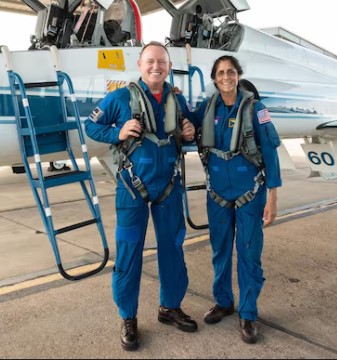The Incredible International Space Station
An example of human inventiveness and international cooperation is the International Space Station (ISS). This massive structure, roughly the size of a football field, orbits Earth at an altitude of 250 miles. Weighing around 460 tons, it took 10 years and over 30 missions to assemble. This remarkable station is a collaborative effort involving five space agencies representing 15 countries. Its size is four times larger than the Russian space station Mir and five times larger than the US space station Skylab.
The dream of a space station dates back to the 1940s. By the 1950s, as the Space Age began, the idea became more popular, with “space planes” and stations frequently appearing in media. The first real steps toward this dream occurred in 1969 when two Russian Soyuz vehicles linked up in space. Over the following decades, advancements in space technology paved the way for the ISS, with construction starting in 1998, thanks to the development of reusable American shuttles.
Initially, the ISS’s research space was primarily used for government projects. Still, a wider spectrum of research and innovation may now be conducted on the station thanks to the options the ISS National Lab offers for both commercial and academic use.
Key Milestones in ISS History
Major turning points have occurred during the ISS’s journey. On January 25, 1984, President Ronald Reagan directed NASA to build an international space station within a decade, envisioning a future where space held enormous potential for commerce. He compared this potential to the way oceans had opened new worlds for clipper ships and Yankee traders, suggesting that space could offer similar opportunities for modern commerce.
Nov. 20, 1998 saw the launch of the Zarya Control Module, the first section of the International Space Station, on a Russian Proton rocket. This module included docking capability and fuel storage, among other necessary features. Shortly after, on December 4, 1998, the Unity Node 1 module, the first U.S.-built component, was launched, joining Zarya and marking the beginning of the ISS assembly.
On November 2, 2000, the ISS welcomed its first permanent occupants. The first crew, which included cosmonauts Sergei Krikalev and Yuri Gidzenko from NASA, spent four months aboard. Their goal was to turn the station into a functioning space station and begin the more than two decades of human habitation in orbit.
On February 7, 2001, the U.S. Laboratory module Destiny was added, increasing the living space by 41% and becoming the primary research laboratory for U.S. experiments. By December 30, 2005, Congress designated the U.S. portion of the ISS as a national laboratory, maximizing its use for various research purposes.
The European Space Agency’s Columbus Laboratory joined the ISS on February 7, 2008, followed by Japan’s Kibo laboratory module on March 11, 2008. These additions marked significant milestones in international collaboration, as different countries contributed their own modules to the station.
On November 2, 2010, the International Space Station (ISS) completed its tenth year of continuous human habitation. As of that date, 202 people have been on board. In July of 2011, NASA announced that the Center for the Advancement of Science in Space (CASIS) has been selected as the management partner for the International Space Station (ISS National Lab). The first research flight from the ISS National Lab took off on September 30, 2013, focusing on protein crystal growth, which can help develop new drugs.
Commercialization of the ISS
The ISS has been operational for over two decades and remains one of the most expensive structures ever built, costing NASA around $4 billion annually. To allocate its budget elsewhere, NASA is opening the ISS to commercial businesses. This move is part of a broader trend toward the commercialization of space. The decreasing cost of launching payloads into orbit is enabling private companies to develop their own space stations and conduct research in space.
One such project is the Axiom Station. Axiom Space plans to build its station by first attaching modules to the ISS. Once complete, Axiom Station will detach to operate independently, nearly doubling the ISS’s usable volume. The first module is expected to connect to the ISS in 2024, with full assembly by 2028. This station will be used for microgravity research, space manufacturing, and housing both private and professional astronauts.
Orbital Reef Space Station, a private low-Earth orbit station for business, research, and tourism, is another fascinating prospect. It is scheduled to come online in the second half of the 2020s and can accommodate up to ten people. This project is a collaboration between several private companies, each contributing unique expertise. Blue Origin provides utility systems and launch capabilities, Sierra Space offers a flexible habitat module and a spaceplane for crew and cargo, Boeing handles science modules and operations, Redwire Space focuses on microgravity research, Genesis Engineering Solutions develops single-person spacecraft, and Arizona State University leads a consortium for research and outreach.
The Lunar Gateway is another anticipated project. As part of NASA’s Artemis mission to return humans to the moon, the Lunar Gateway will orbit the moon and serve as a staging point for lunar exploration and potential Mars missions. Scheduled to launch in November 2024, it will support a crew of four astronauts and involve collaboration with other space agencies, including ESA, JAXA, and CSA.
Starlab is another private space station in development, led by Nanoracks, Voyager Space, and Lockheed Martin. Starlab’s unique feature is its inflatable habitat, providing a large, flexible space for research and commercial activities. Equipped with a robotic arm, power systems, and advanced laboratories, Starlab is set to launch in 2027, supporting a crew of four.
The Future of Space Stations
As NASA looks to focus its budget on other projects, the commercialization of the ISS represents a significant shift in space exploration. Companies like Axiom Space and projects like Orbital Reef are stepping in to take advantage of the unique research opportunities in microgravity and the potential for space tourism and manufacturing.
The goal of the Axiom Station is to increase the capabilities of the International Space Station. By attaching modules to the existing station and eventually operating independently, Axiom Station will nearly double the available space for research and habitation. This modular approach allows for a gradual transition, ensuring that the infrastructure is in place before the station becomes fully operational. The research conducted here will range from scientific experiments to space manufacturing, potentially leading to new technologies and products that could benefit life on Earth.
Orbital Reef represents a different model of space station, focusing on commercial use from the outset. The collaboration between companies like Blue Origin, Sierra Space, Boeing, and others brings together a diverse set of skills and technologies. Blue Origin’s New Glenn rocket will provide the heavy-lift capability needed to launch large modules, while Sierra Space’s LIFE module offers a flexible living space. Boeing’s expertise in science modules and station operations ensures that the station can support a wide range of research activities. Redwire Space’s focus on microgravity research and Genesis Engineering Solutions’ single-person spacecraft add unique capabilities to the station, making it a versatile platform for various uses.
The Lunar Gateway is another crucial development in space exploration. The Lunar Gateway will function as a base for lunar and maybe Mars missions as part of NASA’s Artemis program. Orbiting the moon, it will provide a staging point for astronauts and robotic missions, allowing for more extended stays on the lunar surface and more complex missions. The involvement of international partners like ESA, JAXA, and CSA highlights the global nature of space exploration and the collaborative efforts needed to achieve these ambitious goals.
Starlab, with its inflatable habitat, offers a novel approach to space station design. The large, flexible habitat provides ample space for research and commercial activities, while the advanced laboratories and robotic arm ensure that the station can support a wide range of scientific experiments and industrial processes. The station’s ability to deploy from a single launch makes it a cost-effective solution for establishing a permanent presence in space.
These developments represent the future of space stations and the broader trend toward the commercialization of space. By opening up space to private companies and commercial activities, NASA and its partners are paving the way for new innovations and opportunities. The research conducted on these stations will not only advance our understanding of space but also lead to new technologies and products that could benefit life on Earth.
As we look to the future, the lessons learned from the ISS and these new projects will inform the next generation of space exploration. The advancements made today will pave the way for new discoveries and opportunities in the vast expanse of space. By embracing the potential of space for commerce, research, and tourism, we are taking the next step in humanity’s journey beyond Earth.




